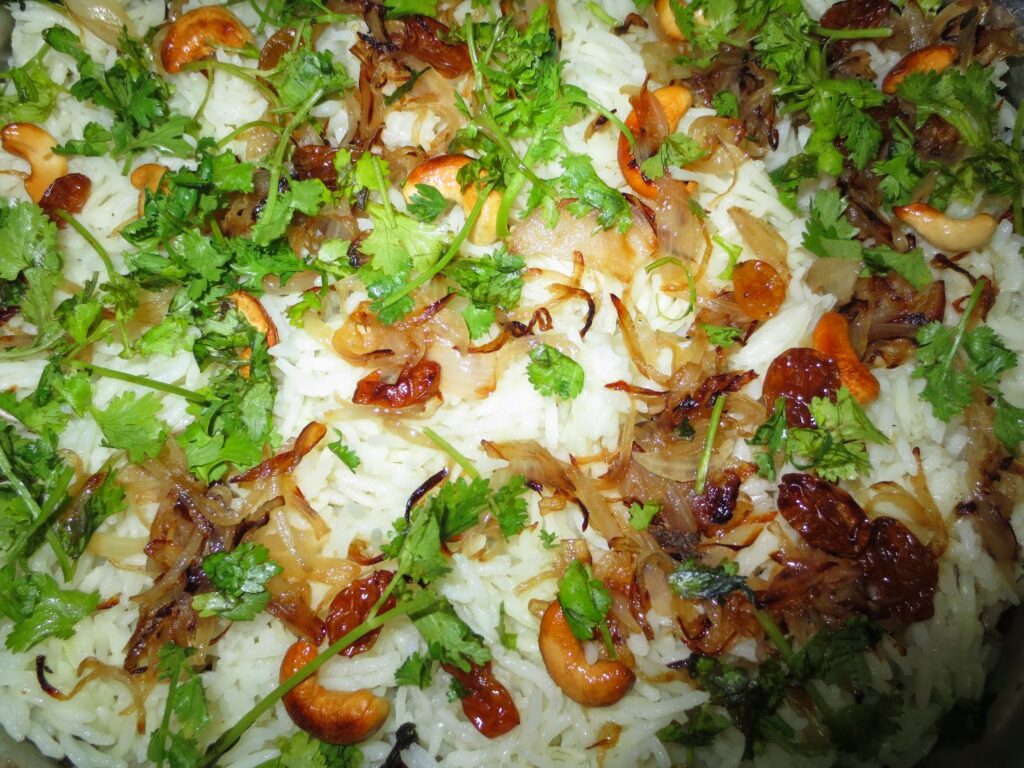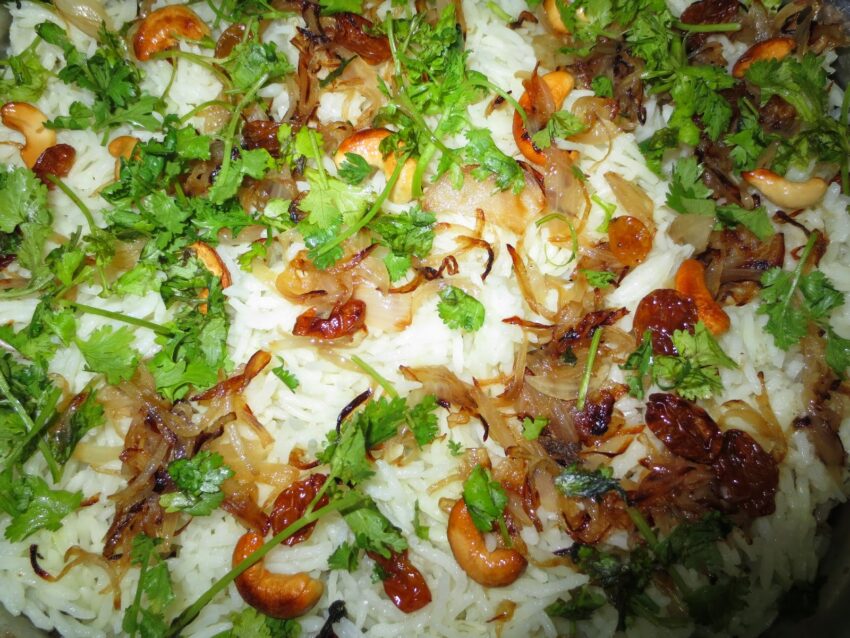
Kottayam Biryani Recipe: The Ultimate Guide to Authentic Flavor
Are you craving the rich, aromatic flavors of authentic Kottayam Biryani? Look no further! This comprehensive guide provides everything you need to recreate this iconic Kerala dish in your own kitchen. We’ll delve into the secrets behind its distinctive taste, from the selection of the finest ingredients to the mastering of traditional cooking techniques. This isn’t just another recipe; it’s a journey into the heart of Kottayam’s culinary heritage, offering expert tips and insights to guarantee a truly unforgettable biryani experience. Get ready to impress your family and friends with a dish that embodies the true spirit of Kottayam.
What Makes Kottayam Biryani Special? A Deep Dive
Kottayam Biryani stands apart from other biryanis due to its unique blend of spices, the use of Kaima rice (also known as Jeerakasala rice), and the distinct cooking style. Unlike some biryanis that rely heavily on chili powder, Kottayam Biryani uses a more balanced combination of spices, resulting in a fragrant and flavorful dish that isn’t overly spicy. The Kaima rice, with its short grains and delicate aroma, contributes significantly to the biryani’s overall texture and taste. The meat, typically chicken or mutton, is marinated in a special spice blend and slow-cooked to perfection, ensuring tenderness and maximum flavor absorption.
The History and Evolution of Kottayam Biryani
While the exact origins of Kottayam Biryani are shrouded in mystery, it is believed to have evolved from the Mughal biryani traditions, adapted to suit the local tastes and ingredients of Kerala. Over time, the dish has been refined and perfected by generations of cooks, each adding their own unique touch to the recipe. Today, Kottayam Biryani is a beloved culinary icon, celebrated for its distinctive flavor and cultural significance.
Core Concepts: The Building Blocks of Authentic Kottayam Biryani
Mastering Kottayam Biryani requires understanding a few core concepts:
- Spice Blending: The precise ratio of spices is crucial. Common spices include cardamom, cloves, cinnamon, star anise, black peppercorns, and mace.
- Meat Marination: A proper marinade tenderizes the meat and infuses it with flavor. Yogurt, ginger-garlic paste, and spice powders are key components.
- Rice Selection: Kaima rice is the preferred choice, but good quality Basmati rice can be used as a substitute.
- Dum Cooking: The biryani is traditionally cooked on a low flame, sealed with dough, allowing the flavors to meld together beautifully.
Why Kottayam Biryani Still Reigns Supreme
In a world of culinary innovation, Kottayam Biryani remains a timeless classic. Its enduring popularity stems from its authentic flavors, its ability to evoke a sense of nostalgia, and its versatility as a dish for both special occasions and everyday meals. The balanced use of spices and the slow-cooking process create a depth of flavor that is simply unmatched.
Expert Ingredient Selection: The Foundation of Flavor
The quality of ingredients is paramount when making Kottayam Biryani. Using fresh, high-quality spices, meat, and rice will significantly elevate the final dish.
Choosing the Right Rice: Kaima vs. Basmati
While Kaima rice is the traditional choice for Kottayam Biryani, it can be difficult to find outside of Kerala. If Kaima rice is unavailable, opt for a good quality Basmati rice with long grains and a delicate aroma. Before cooking, rinse the rice thoroughly to remove excess starch, which will prevent it from becoming sticky.
Selecting the Perfect Meat: Chicken or Mutton?
Both chicken and mutton are commonly used in Kottayam Biryani. For chicken biryani, use bone-in pieces for maximum flavor. For mutton biryani, choose tender cuts like shoulder or leg. Marinate the meat for at least 2 hours, or preferably overnight, to allow the flavors to penetrate deeply.
The Spice Rack: Assembling Your Flavor Arsenal
The spice blend is the heart and soul of Kottayam Biryani. Gather the following spices:
- Cardamom pods (green and black)
- Cloves
- Cinnamon sticks
- Star anise
- Black peppercorns
- Mace
- Bay leaves
- Turmeric powder
- Red chili powder (optional, use sparingly)
- Coriander powder
- Garam masala
Fresh ginger, garlic, and green chilies are also essential for the marinade and the biryani masala.
The Authentic Kottayam Biryani Recipe: Step-by-Step Guide
Here’s a detailed recipe to guide you through the process of making authentic Kottayam Biryani:
Ingredients:
- 1 kg Chicken or Mutton, cut into pieces
- 500g Kaima Rice or Basmati Rice
- 3 Large Onions, thinly sliced
- 2 Large Tomatoes, chopped
- 2 tbsp Ginger-Garlic Paste
- 4-5 Green Chilies, slit
- 1/2 cup Yogurt
- 1/4 cup Mint Leaves, chopped
- 1/4 cup Coriander Leaves, chopped
- 2 tbsp Lemon Juice
- 2 tbsp Ghee
- 2 tbsp Vegetable Oil
- Spices: Cardamom, Cloves, Cinnamon, Star Anise, Black Peppercorns, Mace, Bay Leaves, Turmeric Powder, Red Chili Powder (optional), Coriander Powder, Garam Masala
- Salt to taste
Instructions:
- Marinate the Meat: In a bowl, combine the meat with yogurt, ginger-garlic paste, green chilies, turmeric powder, red chili powder (if using), coriander powder, lemon juice, salt, and a tablespoon of ghee. Mix well and marinate for at least 2 hours, or preferably overnight.
- Prepare the Rice: Wash the rice thoroughly and soak it in water for 30 minutes. Drain the rice and set aside.
- Fry the Onions: Heat vegetable oil in a large pot or Dutch oven. Add the sliced onions and fry until golden brown and crispy. Remove the onions from the pot and set aside. This is called “birista”.
- Make the Biryani Masala: In the same pot, add ghee and the whole spices (cardamom, cloves, cinnamon, star anise, black peppercorns, mace, bay leaves). Sauté for a minute until fragrant. Add the ginger-garlic paste and green chilies and sauté for another minute. Add the chopped tomatoes and cook until they soften.
- Cook the Meat: Add the marinated meat to the pot and cook on medium heat until the meat is browned and the masala is well combined. Add a cup of water and simmer until the meat is tender.
- Layer the Biryani: In a separate pot, bring water to a boil and add the soaked rice and salt. Cook the rice until it is 70% cooked (it should still have a slight bite). Drain the rice and spread it evenly over the meat in the pot. Sprinkle with chopped mint and coriander leaves, and the fried onions (birista).
- Dum Cooking: Cover the pot tightly with a lid and seal the edges with dough (optional). Cook on low heat for 30-45 minutes, or until the rice is fully cooked and the flavors have melded together.
- Serve: Gently fluff the biryani with a fork and serve hot with raita (yogurt dip) and pickle.
Tips and Tricks for Perfect Kottayam Biryani
Here are some expert tips to help you achieve biryani perfection:
- Don’t Overcook the Rice: Overcooked rice will result in a mushy biryani. Aim for rice that is 70% cooked before layering.
- Use a Heavy-Bottomed Pot: A heavy-bottomed pot will prevent the biryani from burning.
- Seal the Pot Tightly: Sealing the pot with dough will create a steam-filled environment, which helps to cook the biryani evenly and infuse it with flavor.
- Rest the Biryani: After cooking, let the biryani rest for 10-15 minutes before serving. This will allow the flavors to meld together even further.
The Science of Flavor: How Spices Work Together
The unique flavor profile of Kottayam Biryani is a result of the synergistic interaction of various spices. Each spice contributes its own distinct aroma and taste, creating a complex and harmonious blend. For example, cardamom adds a sweet and floral note, while cloves provide a warm and pungent flavor. Cinnamon contributes a sweet and woody aroma, while star anise adds a licorice-like flavor. By carefully balancing these spices, you can create a biryani that is both flavorful and aromatic.
Kottayam Biryani Masala Powder: Your Shortcut to Flavor
While using whole spices is ideal, you can also use a pre-made Kottayam Biryani Masala powder for convenience. Look for a reputable brand that uses high-quality ingredients. Adjust the amount of masala powder according to your taste preferences.
Serving Suggestions: Completing the Kottayam Biryani Experience
Kottayam Biryani is traditionally served with raita (yogurt dip), pickle, and papadum. Raita provides a cooling contrast to the rich and flavorful biryani. Pickle adds a tangy and spicy element. Papadum provides a crispy and savory accompaniment.
Variations on the Theme: Exploring Different Kottayam Biryani Styles
While the classic Kottayam Biryani recipe is a masterpiece in itself, there are many variations to explore. Some variations include adding vegetables like potatoes and carrots, while others incorporate seafood like prawns or fish. Feel free to experiment with different ingredients and spices to create your own unique Kottayam Biryani.
Health Benefits of Kottayam Biryani: More Than Just a Treat
While Kottayam Biryani is undoubtedly a delicious treat, it also offers some health benefits. The spices used in the biryani are rich in antioxidants and anti-inflammatory compounds. The meat provides protein, which is essential for building and repairing tissues. The rice provides carbohydrates, which are a source of energy. However, it is important to consume Kottayam Biryani in moderation, as it can be high in calories and fat.
Frequently Asked Questions About Kottayam Biryani
- What is the difference between Kottayam Biryani and other biryanis?
Kottayam Biryani uses Kaima rice, a balanced spice blend, and a unique cooking style that sets it apart from other biryanis.
- Can I use Basmati rice instead of Kaima rice?
Yes, you can use good quality Basmati rice as a substitute for Kaima rice.
- What kind of meat is best for Kottayam Biryani?
Both chicken and mutton are commonly used. Use bone-in chicken pieces for maximum flavor, or tender cuts of mutton like shoulder or leg.
- How long should I marinate the meat?
Marinate the meat for at least 2 hours, or preferably overnight, to allow the flavors to penetrate deeply.
- How do I prevent the rice from becoming sticky?
Rinse the rice thoroughly before cooking to remove excess starch, and don’t overcook it.
- How do I seal the pot for dum cooking?
You can seal the pot with dough, or use a tight-fitting lid and weigh it down with a heavy object.
- How long should I cook the biryani on dum?
Cook the biryani on low heat for 30-45 minutes, or until the rice is fully cooked and the flavors have melded together.
- What should I serve with Kottayam Biryani?
Kottayam Biryani is traditionally served with raita (yogurt dip), pickle, and papadum.
- Can I add vegetables to Kottayam Biryani?
Yes, you can add vegetables like potatoes and carrots to create a vegetable-infused variation.
- Is Kottayam Biryani healthy?
While it offers some health benefits from the spices and protein, consume it in moderation due to its calorie and fat content.
Conclusion: Embrace the Flavor of Kottayam
Kottayam Biryani is more than just a dish; it’s a culinary experience that embodies the rich flavors and cultural heritage of Kerala. By following this comprehensive guide and mastering the techniques, you can recreate this iconic dish in your own kitchen and impress your family and friends with its authentic taste. So, gather your ingredients, fire up the stove, and embark on a culinary journey to the heart of Kottayam! Share your own Kottayam Biryani experiences in the comments below – we’d love to hear your tips and variations!

